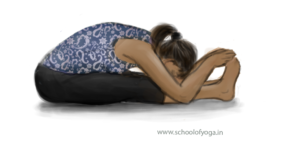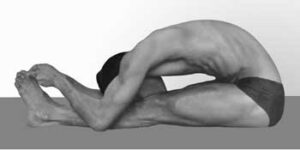What is paścimottānāsana (torso stretching pose)?
Paścimottānāsana or torso stretching pose is an advanced āsana where the practitioner goes from a supine state to a position where the torso is bent over the legs and the face is pressed into the kneews.
How does one perform paścimottānāsana?
- Sthithi position – (starting position)- Lie down on the back, hands at the sides.

Paschimotanasana – Torso Stretching pose - Then, breathe in and take hands over and behind the head.
- After this, breathing out, lift torso up, and moving forward clasp big toe with your hands.
- Bend your face forward and slowly pull your torso towards your knees.
- Pull forward and down until face touches knee.
- Keep legs straight.
- If possible, press face into knee. Hold for 5 counts.
- Release the forward bending pressure and lift face up.
- Breathing in, return the body to supine posture (sthithi – starting position) with hands back over the head.
- Breathe out; bring hands back to the side.
- Breathe normally. Repeat 3 to 6 times.
- The dṛṣṭi (gaze) recommended is in the middle of the knee but one could also focus on the svādhiṣṭhāna-cakra
What are the benefits of practicing paścimottānāsana?

- First, the action of pulling face into the knee strains and strengthens the hamstrings. Additionally, thigh muscles, shoulder and lower back muscles get strengthened.
- Since, abdominal viscera get compressed, their functioning is improved.
- Second, this āsana (exercise) also tones up the complete digestive system, including stomach, liver, spleen, pancreas, small and large intestines.
- Also, the abdominal walls are strengthened because adipose in the tissues get squeezed out.
- Additionally, the action of lifting and moving forward activates the rectal muscles and cures constipation.
- Importantly, the exercise increases intra-abdominal pressure and induces peristalsis.
- This exercise is good for curing obesity, constipation, piles, diabetes, and other digestive ailments.
- Lastly, muscle groups of the back get strengthened, and the sympathetic nervous system is toned-up because it receives copious blood supply.
What are the possible paścimottānāsana contraindications?
- If you have any form of back ache, push yourself only to the point where there is no discomfort. When pain or discomfort starts, stop immediately. With practice, the back will begin to flex better.
- People with cardiac problems, lower back problems and circulatory disorders should not attempt the final position. They should perform this exercise very slowly and stop in case of discomfort or pain.
- This āsana should not be practiced during menstruation or pregnancy.
What does Hatha Yoga Pradeepika say about paścimottānāsana?
Ch1, verse (28) paścimottānāsana– stretching both legs on the ground like a stick, catch the toes with the hands, place the forehead on the knees and rest.
Ch1, verse (29) This paścimottānāsana moves the vital wind to the rear channel. It kindles the gastric fires, makes the loins lean and cures all disease in men.
Some noteworthy points on paścimottānāsana.
Internal Links: Dharma (conditioning), Stress and Situational Awareness, Prana, Asana sequence, Asana scheduling, Asana Focus or gazing, Pranayama, Hatha Yoga Pradeepika
External Links: Prana, Chakra, Pancha Tattva, Pancha Prana, Pancha Kosha, Nadi,
- This āsana is considered to be one of the 32 most important āsana by all ancient texts.
One might encounter the following difficulties when performing this āsana;
- Inability to lift the torso off the ground without lifting the legs as a counter balance.
- Inability to touch toes.
- In both cases, the practitioner should be patient. Firstly, inability to lift torso is quickly overcome with strengthening of lower back and abdominal muscles. Also, one could ask a partner to help by keeping a hand between the shoulder blades as support.
- The case of not being able to touch the toe is more serious but not insurmountable. Breathing out, stretch to the maximum point possible without pain and hold till all the breath is evacuated from the lungs. Breathing in, return to normal position. With time, the muscles will yield and one will be able to get to an optimum position. However, it is important to remember that to reap the benefits of paścimottānāsana, even 70% complete pose is adequate as strength comes to the lower back, abdominal muscles and hamstrings.
- There are also claims that rapidly performed paścimottānāsana reduces adipose tissue in the abdomen and can be used for weight loss. This is not substantiated by experience. Rapidly performed paścimottānāsana requires a deep throw of almost 180° of the upper torso from supine position to final position to enable one to touch toes. Obviously, the slightest misalignment during the action can lead to muscle pulls and cramps. Therefore, one should be very fit and careful when attempting this variation.
- For maximum benefits, one must keep the knees, ankles and toes straight and together. The stretching action yields tremendous benefits by strengthening the calf, hamstring, back of the thigh and lower back. Avoid the natural tendency of separating the ankles to relieve pressure on the back and hamstring. It’s OK to not stretch fully.
